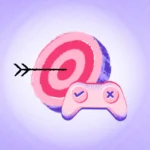The path from game design to UI/UX design might seem like a leap, but it’s actually a natural progression that many successful designers have made. Both fields share fundamental principles around user engagement, experience crafting, and problem-solving through design. If you’re a game designer looking to break into the broader tech industry, your existing skills are more transferable than you might think.
Why Game Designers Make Excellent UI/UX Designers
Game design and UI/UX design share surprising amounts of DNA. Both disciplines require you to understand user psychology, create intuitive interfaces, and guide users through complex systems while maintaining engagement. Game designers are already experts at several key areas that translate directly to UI/UX work.
User-Centered Thinking: Game designers constantly consider the player experience, balancing challenge with accessibility, and ensuring that mechanics serve the overall user journey. This mirrors the UI/UX designer’s focus on user needs and pain points.
Systems Thinking: Games are complex systems with interconnected elements, much like modern digital products. Your experience designing for how different game elements interact gives you a head start in understanding how users navigate between features and screens.
Feedback Loops and Iteration: Game development relies heavily on playtesting and iteration based on user behavior. This aligns perfectly with the UI/UX process of prototyping, user testing, and iterative refinement.
Visual Communication: Whether through UI elements, environmental storytelling, or iconography, game designers excel at communicating information quickly and clearly—a cornerstone of effective UI/UX design.
Identifying Your Transferable Skills
Before diving into your transition strategy, take inventory of your existing game design skills and how they map to UI/UX competencies.
Interaction Design: Your experience creating game controls, menu systems, and player interactions translates directly to designing buttons, navigation patterns, and user flows in apps and websites.
Information Architecture: Organizing game content, skill trees, inventory systems, and level progression requires the same structural thinking needed for organizing website content and app features.
User Research and Testing: If you’ve conducted playtests, analyzed player behavior data, or iterated based on user feedback, you already understand the research methodologies central to UI/UX work.
Prototyping: Game designers often create paper prototypes, digital mockups, or playable builds to test concepts. These skills transfer seamlessly to UI/UX prototyping tools and methodologies.
Visual Design: Experience with game UI, HUD design, iconography, and visual hierarchy gives you a foundation in the visual design aspects of UI/UX work.
Psychology and Motivation: Understanding what motivates players, how to create engagement, and how to guide user behavior through design incentives is valuable in any digital product design role.
Building Your UI/UX Foundation
While your game design background provides an excellent foundation, you’ll need to learn some UI/UX-specific concepts and tools to make a successful transition.
Learn Core UI/UX Principles: Study fundamental concepts like design systems, accessibility guidelines, responsive design, and mobile-first approaches. Resources like Don Norman’s “The Design of Everyday Things” and Steve Krug’s “Don’t Make Me Think” provide essential background.
Master Industry-Standard Tools: Familiarize yourself with Figma, Sketch, or Adobe XD for interface design and prototyping. While game design tools vary widely, these are industry standards in UI/UX work.
Understand Web and Mobile Constraints: Games often have more creative freedom than web or mobile interfaces, which must work across devices, browsers, and accessibility standards. Learn about responsive grids, typography scales, and platform-specific design guidelines.
Study Real-World Applications: Analyze popular apps and websites through a designer’s lens. What makes their navigation intuitive? How do they handle complex information? How do they guide users toward key actions?
Learn User Research Methods: While game testing focuses on fun and engagement, UI/UX research emphasizes usability and task completion. Study methods like user interviews, surveys, card sorting, and usability testing.
Building a Compelling Portfolio
Your portfolio is your ticket to landing UI/UX interviews, and as a career transitioner, you’ll need to be strategic about showcasing relevant work.
Reframe Existing Work: Present your game design projects through a UI/UX lens. Instead of focusing solely on gameplay mechanics, highlight how you solved user experience problems, created intuitive interfaces, or improved player engagement through design decisions.
Create UI/UX Case Studies: Develop 2-3 comprehensive case studies that demonstrate your UI/UX thinking process. These can be redesigns of existing products, solutions to common usability problems, or entirely original concepts. Show your research, ideation, prototyping, and testing process.
Focus on Process: Employers want to understand how you think and work, not just see pretty designs. Document your design process, show iterations, explain your decision-making, and include user feedback where possible.
Include Mobile and Web Work: Since much UI/UX work focuses on mobile apps and web applications, include projects that demonstrate your ability to design for these platforms, even if they’re personal projects or redesign exercises.
Show Versatility: Include work that demonstrates your ability to design for different industries, user types, and platforms. This shows potential employers that you can adapt your skills to their specific needs.
Networking and Breaking In
The UI/UX community is generally welcoming to career changers, especially those with relevant skills from adjacent fields.
Join Design Communities: Participate in online communities like Designer Hangout Slack, local IXDA chapters, or design meetups. These connections often lead to job opportunities and mentorship.
Attend Industry Events: UI/UX conferences, workshops, and local meetups are excellent places to learn current trends and make professional connections. Many cities have active design meetups that welcome newcomers.
Find a Mentor: Look for experienced UI/UX designers who might be willing to provide guidance on your transition. Many designers are happy to help career changers, especially those with interesting backgrounds.
Consider Contract or Freelance Work: Taking on smaller projects can help you build UI/UX experience, expand your portfolio, and make professional connections without committing to a full-time role.
Leverage Your Game Industry Network: Don’t overlook connections from your game design career. Many game companies also work on non-game digital products, and your former colleagues might know of UI/UX opportunities.
Positioning Yourself as a Candidate
When applying for UI/UX roles, your game design background can be either an asset or a concern, depending on how you present it.
Emphasize Transferable Skills: Lead with your strengths in user research, system design, and iterative development. Show how these skills apply to UI/UX work rather than dwelling on game-specific experiences.
Address Potential Concerns: Some hiring managers might worry that game designers are too focused on entertainment over usability. Address this by showcasing your understanding of business goals, conversion optimization, and task-oriented design.
Show Learning and Adaptation: Demonstrate that you’re actively learning UI/UX principles and staying current with industry trends. This shows employers that you’re serious about the transition and committed to growth.
Highlight Unique Perspectives: Your game design background gives you unique insights into user engagement, motivation, and interactive design that many traditional UI/UX designers lack. Position this as a competitive advantage.
Consider Adjacent Roles: Look for positions that bridge your backgrounds, such as UX roles at gaming companies, gamification projects, or interactive media design positions.
Making the Transition Smoother
A successful career transition requires strategic planning and realistic expectations about the timeline and challenges involved.
Start Before You Leap: Begin building UI/UX skills and portfolio pieces while still working in game design. This reduces financial pressure and allows you to make a more gradual transition.
Consider Intermediate Steps: Look for roles that blend your backgrounds, such as UX positions at game companies, mobile app design roles, or positions focused on interactive or entertainment technology.
Be Open to Junior Positions: You might need to accept a step back in seniority as you build UI/UX-specific experience. View this as an investment in your long-term career growth rather than a setback.
Keep Learning: The UI/UX field evolves rapidly, with new tools, methodologies, and best practices emerging regularly. Maintain a growth mindset and stay curious about new developments in the field.
Leverage Your Unique Value: As you gain UI/UX experience, don’t abandon your game design knowledge entirely. Your unique background can be valuable for projects involving gamification, interactive experiences, or engagement-focused design challenges.
The Opportunities Ahead
The transition from game design to UI/UX opens up numerous career paths and opportunities in the growing tech industry. UI/UX designers are in high demand across industries, from startups to Fortune 500 companies, offering greater job security and career flexibility than the often volatile game industry.
Your game design background positions you well for specialized roles in emerging areas like AR/VR interfaces, interactive installations, voice user interfaces, and gamification projects. As technology continues to blur the lines between entertainment and utility, designers with your cross-disciplinary background become increasingly valuable.
The skills you’ve developed in game design—understanding user motivation, creating engaging interactions, and thinking systematically about complex user journeys—are exactly what the UI/UX field needs as digital products become more sophisticated and competition for user attention intensifies.
Making the transition from game design to UI/UX isn’t just about changing careers; it’s about applying your creative problem-solving skills to a broader range of human challenges. The same passion for crafting experiences that drew you to game design will serve you well in creating digital products that improve how people work, communicate, and navigate their daily lives.
With preparation, persistence, and a strategic approach to showcasing your transferable skills, your game design background can become the foundation for a successful and fulfilling career in UI/UX design. The journey might require stepping outside your comfort zone, but the destination offers opportunities to impact millions of users while applying the creative and analytical skills you’ve already developed.


